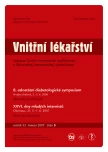Outline of the physiology and pathophysiology of the senses
Authors:
O. Kittnar
Authors‘ workplace:
Fyziologický ústav 1. lékařské fakulty UK, Praha, přednosta prof. MUDr. Otomar Kittnar, CSc.
Published in:
Vnitř Lék 2007; 53(5): 477-482
Category:
Overview
Sense organs are considered as systems that detect information from the outer and inner environment and transfer it to the central nervous system where it is processed by a series of brain structures which make it the basis for the conscious interpretation of the surrounding world. The work discusses sense receptors as nerve structures recording specific forms of energy in our surroundings and their key function, so-called transduction, i.e. the conversion of energy of a given modality to electrical energy of the action potentials of afferent nerves. The information encoded in this form is then brought together in subcortical (thalamic) centres for processing and synthesis in the cerebral cortex. The specific implementation of this general framework is given for each of the main sense systems: somatosensory, sight, hearing, vestibular, taste and smell. The basic disorders of sense perception, their usual aetiologies and the pathogenic mechanisms responsible for their development and symptoms are outlined briefly.
Key words:
senses – receptor – transduction – afferent pathway – thalamus – cerebral cortex
Sources
1. Trojan S et al. Lékařská fyziologie. 4. ed. Praha: Avicenum-Grada Praha 2003.
2. Nečas E et al. Patologická fyziologie orgánových systémů. Praha: Karolinum 2003: Vol 2.
3. Borley NR, Achan V. Instant Physiology. Oxford: Blackwell Publishing 2005.
Labels
Diabetology Endocrinology Internal medicineArticle was published in
Internal Medicine

2007 Issue 5
Most read in this issue
- Inflammatory diseases of the eye
- Tinnitus and diabetes
- Increased activity of the sympathetic nervous system and the possibilities for therapeutic influence
- Olfaction and gustation in diabetes
